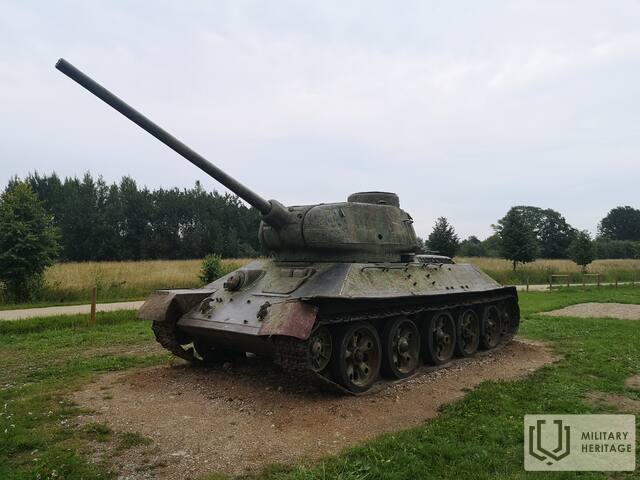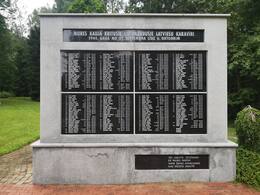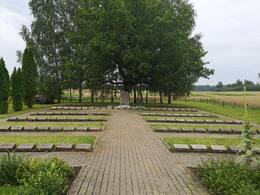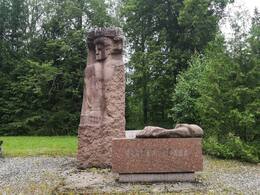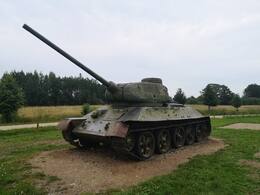More mūšiai
Morės mūšis buvo vienas įnirtingiausių mūšių Latvijos teritorijoje per Antrąjį pasaulinį karą. Jame 19-oji Latvijos legiono divizija atrėmė Raudonosios armijos bandymus prasiveržti į Rygą, o tai leido vokiečių pajėgoms pasitraukti iš Estijos. Mūšis truko nuo 1944 m. rugsėjo 25 d. iki spalio 6 d. Legionieriai didvyriškose kovose atrėmė dešimteriopai pranašesnes Raudonosios armijos pajėgas.
1944 m. rudenį Raudonoji armija užėmė visą Latgalą, sutelkė savo kariuomenę Lubanos pusėje ir suformavo puolimo Rygos įlankos link priešakį, siekdama atkirsti Vokietijos armijų grupės „Nord“ dalis, dislokuotas Pietų Estijoje, taip pat atkirsti 16-ąją armiją. Raudonajai armijai priešinosi Vokietijos 18-oji armija, įskaitant Latvijos legiono 19-ąją diviziją, iš pradžių prie Lubanos ežero, vėliau atsitraukdama Barkavos, Aiviekstės ir Rankos mūšiuose, kol per Vecpiebalgą, Drustus, Sērmūkšius, Skujenus ir Nītauri pasiekė Morę.
1944 m. rugsėjo 25 d. 19-oji divizija užėmė Morės valsčiuje pastatytas Siguldos gynybos pozicijas. Penkias dienas vyko įnirtingos kovos. Į dvi kuopų saugomas pozicijas Morės centre buvo pasiųsti devyni Raudonosios armijos batalionai, atakas rėmė artilerija, aviacija ir tankai. Legionieriai prieštankiniais pabūklais sunaikino 4 tankus. Dėl artilerijos sviedinių trūkumo Latvijos legionieriams dvi dienas teko ginti savo pozicijas nuolatinėje ir itin sunkioje artimoje kovoje.
Rugsėjo 28 d. Raudonajai armijai pavyko pralaužti legionierių pozicijas netoli Kārtužų. Kitą dieną, padedant šešiems vokiečių šturmo pabūklams, per kontrataką pralaužta vieta buvo likviduota. Žuvo daug Raudonosios armijos karių ir jų pulko vadas. Vėlesnėmis dienomis atakos susilpnėjo ir rugsėjo 30 d. Morės mūšis baigėsi. Latvijos legionieriai savo žemėje įvykdė savo misiją – priešas buvo sustabdytas. Naktį iš spalio 5 į 6 d., gavus įsakymą, 19-oji divizija paliko Siguldos gynybines pozicijas, o spalio 6 d. Raudonoji armija su pastiprinimu užėmė tuščius Morės apkasus.
Žuvo apie 200 Latvijos kareivių, apie 650 buvo sužeista, o Raudonoji Armija neteko apie 2700 žuvusiųjų ir 10 000 sužeistųjų, buvo sunaikinti penki T-34 tankai ir numuštas vienas IL-2 bombonešis. Morės mūšis yra ryškus Latvijos kareivio drąsos ir didvyriškumo pavyzdys, įrodytas per šimtmečius.
Daugiau informacijos šaltinių
1. Moreso mūšio muziejaus svetainė. Prieiga per internetą: http://www.moresmuzejs.lv/index.php?nod=21 [žiūrėta 2021-05-08].
2. Nacionalinių ginkluotųjų pajėgų svetainė. Prieiga per internetą: https://www.mil.lv/lv/latvijas-neatkaribas-kars [žiūrėta 2021-05-08].
Susijusi laiko juosta
Susijusios vietos
Moreso mūšio memorialinis parkas
Parkas buvo įkurtas buvusioje mūšio vietoje Morės parapijos centre, kur per pirmąsias dvi 1944 m. Antrojo pasaulinio karo savaites vyko dideli mūšiai, išlaikant strategiškai suformuotą gynybos liniją ir neleisdami Raudonajai armijai prasiveržti į Rygą, taip paveikdami tolesnę istorijos eigą.
Čia galite pamatyti karo laikų relikvijų fragmentus ir bunkerių vietas. Morės mūšių memorialiniame parke yra skulptoriaus H. Sprincio sukurtas atminimo akmuo ir atminimo lenta su 186 karių vardais, iškaltais granite.
Raudonosios armijos brolių kapinės More mieste
Raudonosios armijos karinės kapinės yra pagrindinio kelio per Morę pakraštyje. Jose palaidoti apie 2000 karių, žuvusių per Morės mūšį. 1974 m. kapinės buvo sutvarkytos ir atidengtas skulptoriaus B. Grīslės paminklas.
More mūšių muziejus
Muziejus yra Morėje, V319 greitkelio pakraštyje. Jis skirtas 1944 m. rudenį vykusiems Morės mūšiams tarp Raudonosios armijos ir Vokietijos armijos Latvijos legiono. Parodoje eksponuojamas mūšio lauko maketas, ginklai, apdovanojimai, karių uniformos ir karinė įranga. Morės mūšių muziejų ir memorialinį parką įkūrė buvę Latvijos legiono kariai, dalyvavę Morės mūšiuose. Memorialiniame parke yra apkasų, žeminių ir mūšio laukų. Mūšiai Morės apylinkėse buvo tik dalis didelio masto Raudonosios armijos Baltijos puolimo operacijos, kurioje dalyvavo iš viso 900 000 karių ir daug karinės technikos vienetų. Morės apylinkėse buvo įrengta dalis Vokietijos armijos įtvirtinimų sistemos, kurioje Latvijos legionieriai sutrukdė Raudonajai armijai prasiveržti į Rygą. Tai leido Vokietijos armijai išvesti savo pajėgas iš Estijos ir išvengti pralaimėjimo. Raudonosios armijos vadovybė tikėjosi, kad priešo pasipriešinimas netoli Morės bus trumpalaikis, ir atkakliai tęsė nepasiruoštus ir nekoordinuotus puolimus, patirdama didelių nuostolių. Vietos pranašumai ir Latvijos legionierių koviniai pajėgumai suvaidino svarbų vaidmenį tolesnėje karo eigoje. More yra Latvijos legionierių brolių kapinės ir Raudonosios armijos karių kapinės.
Susijusi istorija
Neatpažinti kareiviai. Kovos karininko istorija.
Morės mūšis – tai Antrojo pasaulinio karo paskutiniojo etapo epizodas, turėjęs didelę reikšmę tolesnei karo eigai Latvijos teritorijoje. Morės mūšis – tai karo veiksmai, vykę nuo 1944 m. rugsėjo 25 d. iki spalio 5 d. Siguldos gynybos linijoje, Morės valsčiaus teritorijoje. Maždaug 12 km ilgio Siguldos gynybos linijos apkasuose Latvijos legiono 19-osios divizijos kariai, 10 dienų kovoję sunkiuose mūšiuose, turėdami 10–15 kartų didesnę priešo persvarą, sustabdė Raudonosios/Sovietų armijos dalinių puolimą Rygos link.




